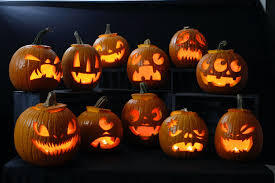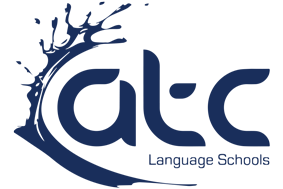Halloween is a festival widely celebrated with costumes, trick-or-treating, and haunted houses, but not many know it comes from old Irish traditions. While modern Halloween has taken on a variety of cultural influences, its foundation lies in the Celtic festival of Samhain (pronounced “sa-win“), a time of transition and supernatural significance. Let’s explore the rich history of Halloween, tracing its evolution from ancient Celtic rituals to the modern celebration known today.

Jack-O-Lantern
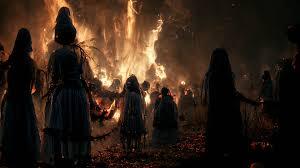
Samhain
The Celtic Festival of Samhain
The story of Halloween begins with Samhain, a festival celebrated by the ancient Celts over 2,000 years ago. Samhain, which means “summer’s end” in Old Irish, marked the end of the harvest season and the beginning of winter. This festival was not only a time to gather resources for the colder months but also a moment when the boundary between the living world and the spirit world was believed to be at its thinnest.
During Samhain, the Celts believed that the spirits of the dead could return to the earth. To make the spirits happy and ask for their guidance, they held large bonfires, performed rituals, and offered food and drink. The presence of otherworldly beings also meant that the living needed protection from any angry spirits. People would disguise themselves in costumes made of animal skins and masks to avoid being recognized and harmed by these spirits.
The Influence of Roman and Christian Traditions
As the Roman Empire expanded into Celtic territories, Roman festivals began to merge with Samhain. Two Roman holidays, Feralia, a day in late October to honour the dead, and Pomona, the goddess of fruit and trees, influenced the Samhain traditions. The apple, a symbol associated with Pomona, may have led to apple bobbing becoming popular in Halloween festivities.
With the spread of Christianity, the Church sought to replace pagan festivals with Christian ones. Pope Gregory III moved the celebration of All Saints’ Day to November 1st, which became known as All Hallows’ Day. The night before, October 31st, was thus referred to as All Hallows’ Eve, eventually shortened to Halloween. Despite these changes, many Samhain traditions persisted, blending with Christian practices to form the basis of the modern Halloween.

Bonfire
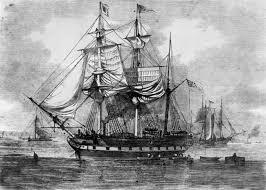
Coffin Ships
Irish Immigration and the Spread of Halloween
The great Irish migration to America during the 19th century played a huge role in shaping Halloween as we know it today. Fleeing the tragic Great Famine, millions of Irish immigrants brought their customs and traditions with them to the North America. Among these was the celebration of Halloween, which quickly gained popularity across the United States.
One of the most iconic Halloween symbols, the jack-o’-lantern, originated from an Irish myth about a man named Stingy Jack. According to the legend, Jack tricked the Devil and was doomed to wander the earth with only a carved-out turnip to light his way. In America, pumpkins, which were more plentiful and easier to carve than turnips, became the lanterns of choice. This practice of carving pumpkins into lanterns continues to be a beloved Halloween tradition.
The Evolution of Halloween Traditions
Over time, Halloween evolved from its solemn and supernatural roots into a more community-centered holiday. By the early 20th century, Halloween in America had become a night of parades, and parties. Schools and communities organized events to keep the festivities safe and enjoyable, leading to the decline of pranks and vandalism that were once associated with the night.
Wearing costumes, a practice dating back to Samhain, became more elaborate. Children and adults wear costumes ranging from spooky ghosts and witches to pop culture icons. This transformation of Halloween into a night of fantasy and fun significantly contributed to its widespread appeal.
Trick-or-treating, knocking on your neighbour’s door and asking for sweets, is another staple of Halloween, also has its origins in ancient and medieval practices. During Samhain, people would go door-to-door offering prayers for the dead in exchange for food.
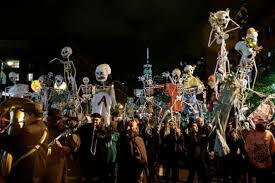
Modern Halloween

Jack-O'-Lanterns
The Globalization of Halloween
While Halloween is most popular in the United States, its celebration has spread globally, influenced by American media and culture. Countries around the world have adopted and adapted Halloween traditions, blending them with their own local customs and festivities.
In Ireland, where it all began, Halloween remains a vibrant and cherished holiday. Cities and towns across the country host parades, fireworks, and events that honor both the ancient traditions of Samhain and the modern festivities of Halloween. The city of Derry, in particular, is known for its spectacular Halloween celebrations, attracting visitors from around the world.
The Cultural Significance of Halloween
Despite its commercialization, Halloween retains a deep cultural significance. It serves as a reminder of the cycle of life and death, the changing seasons, and the human desire to understand and connect with the unknown. The customs and rituals associated with Halloween reflect a universal need to honour our ancestors, celebrate the harvest, and confront our fears.
In modern times, Halloween has also become a platform for creativity and self-expression. From intricate costumes to elaborate haunted houses, people of all ages engage in activities that allow them to explore different facets of their identities and imaginations. This aspect of Halloween fosters a sense of community and shared experience, bringing people together in celebration and fun.
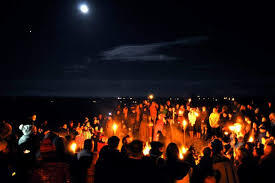
Samhain Bonfire
The journey of Halloween from its ancient Celtic origins to its present-day global celebration shows the power of tradition and cultural adaptation. Beginning from the Irish festival of Samhain, Halloween has changed over centuries of influence from Roman, Christian, and American customs. It has become a unique blend of history, folklore, and modern practices, celebrated with enthusiasm by millions of people around the world.
As we carve pumpkins, dress in costumes, and enjoy the spooky festivities each October 31st, we are participating in a tradition that stretches back thousands of years. Halloween’s ability to change and grow over time shows how special the holiday is for people. Whether viewed as a night of fun, a time to honour the past, or a celebration of the supernatural, Halloween continues to captivate and enchant, just as it did for the ancient Celts so long ago.
